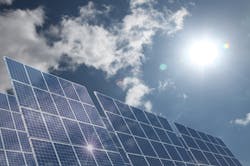Floating solar system to power water treatment plant in California
HOLTVILLE, Calif. — Dec. 9, 2015 — The City of Holtville in California is to install a floating solar system to power its new water treatment plant, according to a press release.
The one-megawatt system includes 276 rafts, 3,576 panels and 12 treatment pumps and is expected to generate 20 percent more power than a fixed land-based system, noted the release.
Australian supplier Infratech Industries said in the release that this will be its first export of the technology. Infratech deployed its first floating solar system in Jamestown, South Australia, earlier this year in a climate similar to that of Holtville.
The floating solar power system in Holtville will reduce evaporation of the town’s drinking water supply and decrease its reliance on chemicals to treat the water, stated the release.
By providing shade for the water, the solar panels limit the photosynthesis process that creates blue-green algae, reported the release. At the same time, they keep the surface of the water cool and further improve water quality.
“Our residents use the water for drinking and irrigation, so this installation means the quality and taste of that water will improve while also ensuring we are on our way to meeting California’s renewable energy target of 50 percent by 2030,” commented Holtville Council member David Bradshaw, who serves as assistant water manager for community-owned utility Imperial Irrigation District, in the release.
Holtville is known as the “winter salad bowl” of the U.S. with a harvest of more than 80 crops, and Bradshaw pointed out that the floating solar system will enable the town to save agricultural space for farming, shared the release.
“Our decision to use Infratech’s floating solar system means we are not losing valuable farmland to massive solar farms; we can use three existing ponds and save our soil for increasing our capacity to produce crops,” he said in the release.
What’s more, with Holtville situated near the San Andreas Fault, the floating system also has the advantage of being able to withstand earthquakes and tremors, stated the release. The system is being shipped from Australia to the U.S. and is expected to be fully installed and operational by mid-2016.
You can find the entire release here.
